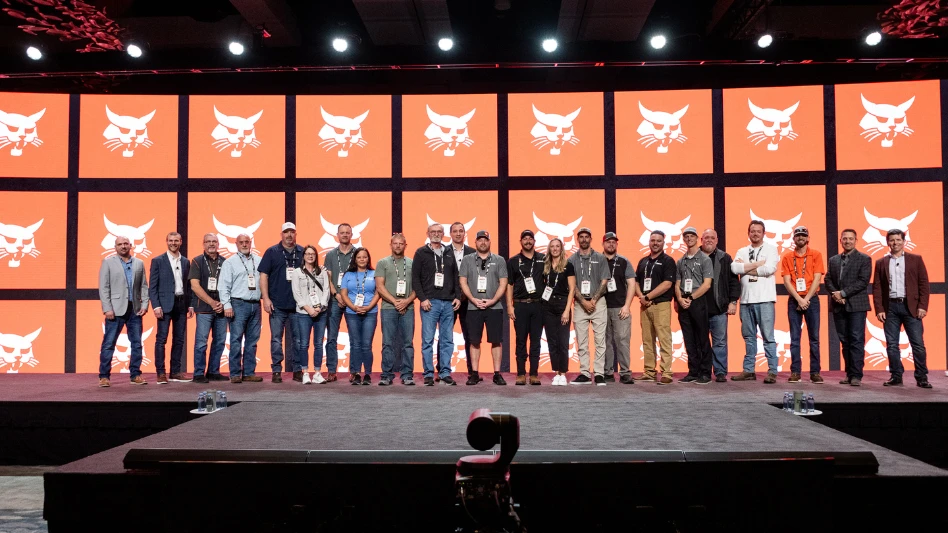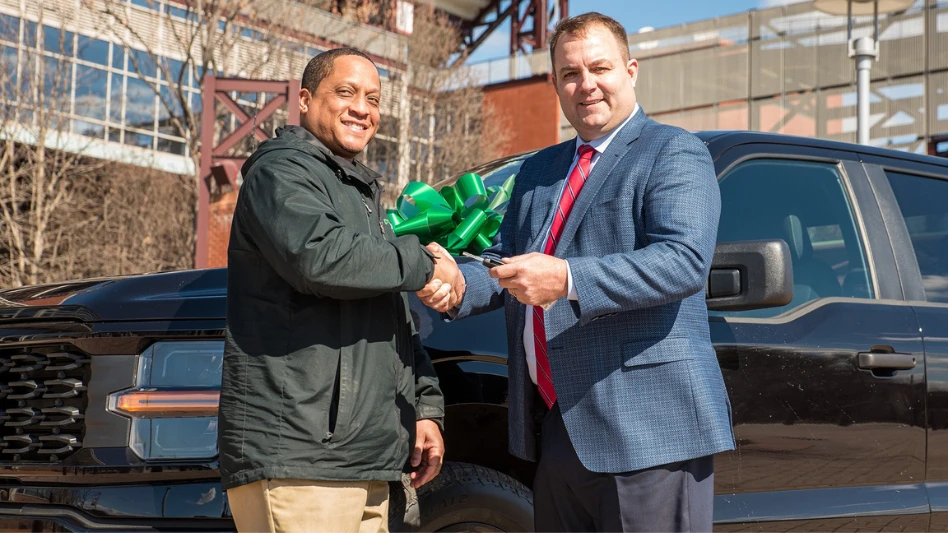When it comes to skid-steers, a general consensus is that most contractors can’t remember how their business functioned prior to owning one. The machine’s versatility, affordability and productivity have made it a popular piece of equipment in the landscape industry today.
“I can’t imagine not having one now after having one for so long,” says Tony Catanzaro, who purchased his first skid-steer more than 10 years ago. “We use our machine for every single one of our jobs.”
|
|
Catanzaro, owner of Millington, N.J.-based Regency Landscape, is not alone. Lawn & Landscape research says 10.6 percent of contractors have purchased a skid-steer within the past 12 months, and 14 percent plan to purchase one in the next 12 months. According to Uniform Commercial Code filings, of all skid-steers leased in the U.S., one in three is leased specifically for the landscape industry, a trend that has been consistent for many years, says Jorge de Hoyos, platform marketing manager for New Holland, Carol Stream, Ill. Most skid-steer owners have a daily use for their machines, and many even use them year-round for snow removal services (see the Snowy Weather sidebar).
With their wide range of attachments, there isn’t much skid-steers can’t do. Contractors can plant trees using an auger, irrigate lawns with a trencher, lay seed with a soil conditioner and transport thousands of pounds of sod or bricks with a pallet fork. They can also clear city streets and jobsites with a sweeper, loosen soil with a tiller, install a pond with a backhoe and place boulders with a grapple, just to name a few examples.
“What many landscape contractors aren’t aware of are all of the attachments that can be used to complete as many jobs as possible,” says Rob Otterson, market segmentation manager for Bobcat, West Fargo, N.D. “The contractor who researches and is aware of all of the options will be presented with more opportunities to grow his business.”
VERY VERSATILE. While versatility has no doubt contributed to the machine’s popularity, other factors within the economic market as a whole have increased the benefits of owning a skid-steer. One such factor is the recent trend of low interest rates, which, according to Gregg Zupancic, product marketing manager for John Deere, Moline, Ill., spur building growth, particularly of small to medium-sized commercial buildings and housing developments. The concern of labor shortages is another reason many contractors turn to the skid-steer.
“Today, it is harder to find enough good labor,” Zupancic says. “Many contractors would rather purchase a skid-steer than hire four or five guys with shovels.”
Contractors agree that, although the purchase of a skid-steer is not an investment to be taken lightly, the machine can often be more reliable and productive than a crew. Typically, the amount of work normally performed by three or four men can be performed by one man and a skid-steer. “Skid-steers are certainly big investments but, from a business point, you can either spend your money on employees or machinery,” says Kathy Krubert, manager, M.J.B. Services, Elkhorn, Wis. “With regular preventive maintenance, machinery can last longer and be more efficient.”
| ASSESSING ATTACHMENTS |
According to Jorge de Hoyos, platform marketing manager for New Holland, Carol Stream, Ill., the average cost of skid-steer attachments ranges from $1,000 for basic pieces like buckets and forks to $5,000 for more specialty pieces like high-flow trenchers and soil preparers. Based on Lawn & Landscape research, 10.1 percent of landscape contractors polled purchased one or more skid-steer attachments in the past 12 months, spending an average of $6,880, and 15.1 percent plan to invest in attachments in the next 12 months. The countless abilities of skid-steer attachments have allowed some contractors to diversify their businesses in ways they never imagined. “Having a skid-steer has really diversified my fleet,” says Catanzaro. “Some of the attachments are key to doing a job efficiently.” Currently, Catanzaro owns a bucket and a pallet fork, but has rented other attachments when needed for a specific job, which is quite common among landscape contractors. According to Otterson, renting attachments is a great option for contractors who receive requests for jobs they don’t typically do. The average cost of renting attachments is about $50 per day and $500 per month for basic pieces like buckets and forks, to between $75 to $100 per day and $1,000 per month for more complicated pieces like a backhoe or a trencher. “Renting attachments provides a landscape contractor with the option of exploring new services and determining whether they fit his business with only a minor investment,” Otterson says. |
However, another take on the skid-steer is that it is not exactly a labor replacement, but rather a labor enhancement. “It doesn’t matter how strong the person is or how many diggers you have, the human body will not generate 6,000 pounds of break-out force when digging with a large shovel,” de Hoyos says. “The skid steer does, but you still need that operator to run the machine and run it well.”
According to skid-steer manufacturers, operating a skid-steer is relatively easy – another one of the machine’s more attractive assets, as it increases productivity and decreases downtime. “It is fairly simple to teach someone how to operate a skid-steer,” explains Mark Rasevic of Rasevic Landscaping Co., Bethesda, Md. “It’s nowhere near as complicated as teaching someone to use a bull dozer.”
And owning a skid-steer is not nearly as costly either. According to Otterson, skid-steers are among the most affordable pieces of landscape equipment, with average costs ranging from about $16,000 to $36,000, depending on brand and amenities. According to Lawn & Landscape research, landscape contractors polled spent an average of $27,580 on skid-steers in the past year.
LITTLE LUXURIES. Amenities that can up the price of a skid-steer include anything from the various attachments to more hydraulic power to simply a bigger machine. However the additions that most contractors are splurging for these days are those that increase operator comfort. Luxuries such as heat and air conditioning, adjustable seating, interior dome lights and noise reduction features have drastically improved conditions within the cab. Some skid-steers even come equipped with cellular phone and laptop computer hook-ups, and manufacturing representatives say that additional features will be added to skid-steers in the near future.
“Other than making them easier to get in and out of, and maybe adding a CD player, I can’t really think of any other ways to improve the skid-steer,” Catanzaro says. “They have really come a long way.”
According to Kent Pellegrini, skid-steer loader and multi-terrain loader industry manager for Caterpillar, Peoria, Ill., contractors should expect to see skid-steers with increased power and versatility, as well as additional comfort and safety features, this year.
“Skid-steer developments should increase the machines’ versatility and help contractors save time and work more effectively,” Pellegrini says. “The increased comfort and safety aim to help contractors meet the challenges they face in building their businesses and assure them that their workers go home safe at the end of the day.”
One of Catanzaro’s favorite skid-steer features is the automatic detach, which allows operators to switch attachments with the press of a button. “It is a huge time-saver and is also a safer way to switch attachments to perform a different task,” he says.
Other features contractors view as important when purchasing a skid-steer are accessibility of the controls, maneuverability, visibility from the cab, hydraulic power, interchangeable parts and serviceability. Others feel that the ability to purchase the machine locally is another huge advantage because it allows them to easily establish a relationship with their dealer, which comes in handy for emergency maintenance and additional training, as well as future purchases.
“Local product support is key for contractors,” says de Hoyos. “Building a habitual relationship with a dealer, no matter what brand, is ideal.”
This relationship between the dealer and the customer often begins before a purchase even takes place, as most manufacturing companies provide an opportunity for contractors to test a particular machine before buying it. These “demos” allow the contractor to ensure they are purchasing the right machine for their needs and gives them a chance to learn how to operate the equipment under the guidance of a professional.
“Trying out the machine to see if it performs the appropriate functions prior to purchasing it is a good way to avoid problems down the road,” Zupancic says. “The demos are free, come with little obligation and are pretty common among most big-name manufacturers.”
| SNOWY WEATHER |
Skid-steers are commonly used for snow removal during the seasons when regular landscape jobs dry up, says Gregg Zupancic, product marketing manager for John Deere, Moline, Ill. “They work well because of their higher ground-pressure and faster speeds,” he says. One way to decrease the downtime of a skid-steer and to generate extra revenue during the off-season months is to use the machine for snow removal and other snow-related tasks, which is a service many landscape contractors opt to offer. Mark Rasevic, owner of Rasevic Landscaping Co. and co-owner of Rasevic Snow Services, both based in Bethesda, Md., agrees that his decision to start his snow removal business in the mid-1990s with his brother, Paul, was a great way to utilize the skid-steers and other landscape equipment he already owned. When using their skid-steers for snow removal, Rasevic and his crew primarily utilize a snow pusher to clear and pile snow, and a bucket to scoop and relocate it, as well as to haul salt. According to Rasevic, other contractors also use snow plow blades and snow blowers, although he has found these hydraulic attachments can be pretty costly. “The hydraulic snow removal attachments can be more costly than regular skid-steer attachments,” Rasevic says. “But they are more efficient when trying to eat through 2 feet, rather than, say, 4 inches, of snow.” On average, hydraulic attachments for snow removal can cost anywhere from 3 to 7 percent more than basic skid-steer attachments. A scraper attachment is another tool that is ideal for clearing large amounts of hard-packed snow and ice. According to Rob Otterson, market segmentation manager for Bobcat, West Fargo, N.D., the tool has a self-sharpening edge that can slide underneath snow and ice and onto the pavement to create a smooth surface. Additional skid-steer attachments that can come in handy during the winter months are angle brooms and whisker-push brooms, which can sweep snow off of sidewalks, parking lots and driveways. A V-blade is another versatile attachment that can be configured into five different tools to make snow removal a snap: a straight blade, a V-cut blade, a scoop blade and a 30-degree left or right angle blade. According to David Daniels, brand marketing manager for New Holland, Carol Stream, Ill., the prices of snow-specific skid-steer attachments can range from $1,000 for buckets, to $3,000 for blades, to $4,000 for pushers to $6,700 for snow blowers. Snow attachments can also be rented for about $400 per month for buckets, $400 to $500 per month for blades and pushers and about $750 per month for blowers, Daniels says. |
REASONS TO RENT. For reasons such as financial restrictions or lack of necessity, purchasing a skid-steer is not always a viable option for every company. So many contractors rent the machines on an as-needed basis until they feel that owing one would be a better investment. According to Zupancic, 50 percent of all skid-steers rented are used in the landscape industry, with prices varying based on region, machine size and rental duration. According to Zupancic, the cost of renting a skid-steer ranges from between $150 to $200 per day to $1,500 to $2,000 per month.
“We rented skid-steers for a few years before purchasing one, and we still rent bigger or different machines when needed,” Catanzaro says. “For example, we have been renting track skid-steers pretty often lately.”
Tracked skid-steers, which run on rubber tracks instead of wheels, are popular among contractors because of their ability to perform well in wet or soggy conditions without causing much turf damage. Tracked machines can be more costly than their wheeled counterparts, with prices ranging from $35,000 to $55,000. Costs of renting a tracked skid-steer range from $200 to $250 per day to $2,000 to $2,500 per month. Regardless, de Hoyos predicts consistent growth in the track loader industry within the next five years.
Rasevic says his tracked skid-steer is particularly helpful when working on already established landscapes, as its “soft footprint” leaves little evidence that his crew was ever there.
“Both wheeled and tracked machines can be better depending on if you’re working with wet or dry soil,” he says. “Like any construction job, you need different tools for different tasks.”
PURCHASING PRECAUTIONS. Versatile, efficient, affordable, easy to use, even comfortable – are there any drawbacks to purchasing a skid-steer?
A seemingly common-sense, but nonetheless important, suggestion is to make sure your company has a significant need for a skid-steer before making the purchase. “You have to be sure your business is big enough and has enough work to justify owning a skid-steer,” Catanzaro says. “If the machine will have a lot of downtime, it’s really not worth the investment.”
Another thing contractors stress is that, when it comes to skid-steers, size does matter. Be sure to purchase a skid-steer that is big enough to perform the necessary jobs, but small enough to haul and fit where needed.
“A common mistake made when purchasing a skid-steer is buying one too small that it underperforms or too large that it can’t fit in your truck or in the average backyard,” Zupancic says. “If your truck is not large enough, you or a member of your crew might be required to get a commercial driver’s license, which is an unforeseen cost and requires additional training.”
Along this same line that bigger is not always better, manufacturers also advise not purchasing a skid-steer based solely on horsepower. “Engine horsepower alone is not a good indicator of performance and has little to do with a machine’s rated operating capacity and breakout or lift forces,” Pellegrini says. “Other factors like hydraulic systems, machine weight, wheelbase, machine balance and axel torque could have significantly more impact on a machine’s performance over horsepower. Manufacturers often increase machine horsepower in order to overcome inefficiencies such as weight, balance or inefficient drive pumps or motors.”
According to Pellegrini, other mechanical aspects to be aware of when purchasing a skid-steer are the radial and vertical lifting arrangements. Radial lifts move in an arc or radius fashion, and have more strength and durability at mid-lift. Vertical lifts maintain a more vertical lift-path and can generally reach higher heights. Depending on your needs, a radial or vertical lift may be more functional.
The abilities of the skid-steer have come a long way. “I have never seen a company that truly needed a skid-steer regret their decision to purchase one,” points out Dan Walsh, a sales representative for John Deere, San Diego, Calif. And, with more improvements and developments to come, it is likely that the skid-steer will continue to grow in the landscape industry. “Manufacturers have really seemed to work out all of the kinks in the last decade or so,” Rasevic says. “These machines run like bullets.”

Explore the January 2007 Issue
Check out more from this issue and find your next story to read.
Latest from Lawn & Landscape
- North by Northwest's charitable act for the Ronald McDonald House Charities
- Coxreels expands V-100 Series product line
- Landscape Workshop expands with 2 acquisitions
- Wilson360 adds Daniel Grange as new consultant
- Batman and business
- CH Products releases new tree stabilizer
- Savannah Bananas founder Jesse Cole to speak at Equip Exposition
- Catch up on last year's Benchmarking report






